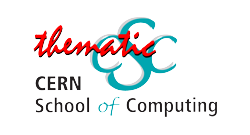Efficient Parallel Processing of Future Scientific Data
Introduction
- Future scientific data processing: challenges in HEP and other sciences, commonalities and differences.
- The prime role of software in modern big science.
- Parallelism and asynchronism: computation and I/O.
- Evolution of hardware and platforms, consequences on data analysis procedures and tools.
Track 1: Technologies and Platforms
Introduction to Efficient Computing
- The evolution of computing hardware and what it means in practice
- The seven dimensions of performance
- Controlling and benchmarking your computer and software
- Software that scales with the hardware
- Advanced performance tuning in hardware
Intermediate Concepts in Efficient Computing
- Memory architectures, hardware caching and NUMA
- Scaling out: Big Data – Big Hardware
- The role of compilers and VMs
- A brief look at accelerators and heterogeneity
Data Oriented Design
- Hardware vectorization in detail – theory vs. practice
- Software design for vectorization and smooth data flow
- How can compilers and other tools help?
Summary and Future Technologies Overview
- Teaching program summary and wrap-up
- Next-generation memory technologies and interconnect
- Rack-sized datacenters and future computing evolution
- Software technologies – forecasts
Track 2: Programming for concurrency and correctness
Scientific software programming: a modern approach
- Introduction: Amdahl's law, Performance and correctness of codebases
- Modern C++: new constructs, their advantages
- Exploit modern architectures using Python
- Near the hardware: the role of compilers
- Understanding the differences and commonalities of data structures, metrics for their classification, concrete examples
Expressing Parallelism Pragmatically
- Trivial asynchronous execution
- Task and data decomposition
- Threads and the thread pool model
- In depth comparison of threads and processes, guidelines to choose the best option
Protection of Resources and Thread Safety
- The problem of synchronization
- Useful design principles
- Replication, atomics, transactions and locks
- Lock-free programming techniques
- Functional programming style and elements of map-reduce
- Third party libraries and high level solutions
Ensure Correctness of a Parallel Scientific Application
- Correctness and reproducibility of a scientific result
- Stability of results and testing: regression, physics performance, tradeoffs
- Enforce avoiding thread unsafe constructs: focus on static analysis
- Algorithms for detecting synchronisation pathologies: focus on the DRD and Helgrind tools
- Elements of the GNU debugger: introduction and specific usage in the multithreaded case
Track 3: Effective I/O for Scientific Applications
Structuring data for efficient I/O
- Pro/cons of row-column and mixed formats
- compression and its efficiency dependencies on variable types, impact of data format
- Data addressing : limitation of hierarchical approach, usage of flat namespaces
- Stateful vs stateless interfaces for namespaces and I/O
Many ways to store data
- Storage devices and their specificities
- Data federation
- Parallelizing files storage
- Introduction to the Map/Reduce pattern
Preserving Data
- Risks of data loss and corruption
- Data consistency (checksumming)
- Data safety (redundancy, parity, erasure coding)
Key Ingredients to achieve effective I/O
- Asynchronous I/O
- I/O optimizations
- Caching
- Influence of data structures on I/O efficiency
